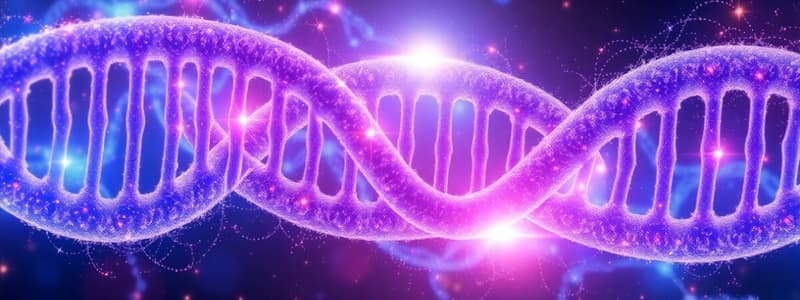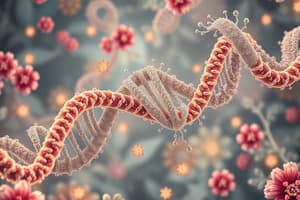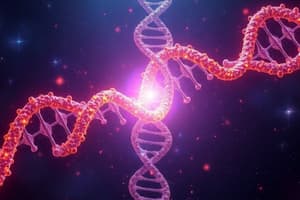Podcast
Questions and Answers
What is the central dogma of molecular biology?
What is the central dogma of molecular biology?
- Proteins can be directly converted back into RNA.
- DNA converts directly into protein.
- RNA makes protein, and protein makes DNA.
- DNA makes RNA, and RNA makes protein. (correct)
Which process involves the removal of non-coding sequences from mRNA?
Which process involves the removal of non-coding sequences from mRNA?
- Transcription
- Splicing (correct)
- Translation
- Replication
During transcription, RNA polymerase moves along the DNA in which direction?
During transcription, RNA polymerase moves along the DNA in which direction?
- Left to right
- 5' to 3'
- 3' to 5' (correct)
- Right to left
What is the first step in the translation process?
What is the first step in the translation process?
What role do activator proteins play in transcription?
What role do activator proteins play in transcription?
What happens when a ribosome reaches a stop codon during translation?
What happens when a ribosome reaches a stop codon during translation?
What is a key component of DNA structure?
What is a key component of DNA structure?
Which of the following best describes translation?
Which of the following best describes translation?
Flashcards
Central Dogma of Molecular Biology
Central Dogma of Molecular Biology
The flow of genetic information, where DNA makes RNA, and RNA makes protein. Information cannot go back from protein to DNA or RNA.
Transcription
Transcription
The process of copying DNA information into mRNA.
Translation
Translation
The process of using mRNA information to build proteins.
RNA polymerase
RNA polymerase
Signup and view all the flashcards
mRNA
mRNA
Signup and view all the flashcards
tRNA
tRNA
Signup and view all the flashcards
Start Codon
Start Codon
Signup and view all the flashcards
Stop Codon
Stop Codon
Signup and view all the flashcards
Study Notes
Central Dogma of Molecular Biology
- Explains the flow of genetic information in a biological system
- DNA makes RNA, and RNA makes protein
- Information cannot be transferred back from protein to protein or nucleic acid
DNA Structure
- Composed of carbon, nitrogen, oxygen, phosphorus and hydrogen atoms
- Made of nucleotides
- Nucleotides contain phosphorylated ribose sugar and a nitrogenous base (adenine, thymine, cytosine, or guanine)
Transcription Process
- RNA polymerase binds to DNA at the transcription start site
- Moves along DNA (3' to 5') to produce mRNA
- Reaches a stop sequence, and mRNA is released
- Activators bind to enhancer sequences, causing DNA to bend, bringing them closer to the gene promoter sequence
- Other transcription factors join activators, forming a complex that binds to the promoter
- This complex allows RNA polymerase to bind to the promoter region
Translation Process
- Splicing removes non-coding introns from mRNA before translation
- Initiation at start codon AUG
- tRNA with a complementary anticodon binds to the start codon
- Ribosomal subunits combine, forming a complex and tRNA enters the peptidyl site
- A tRNA molecule with the corresponding anticodon enters the aminoacyl site
- Peptide bonds are formed
Ribosome Function
- Ribosome moves along the mRNA molecule
- When a stop codon is reached, a release factor enters the A site and releases the polypeptide
Studying That Suits You
Use AI to generate personalized quizzes and flashcards to suit your learning preferences.





